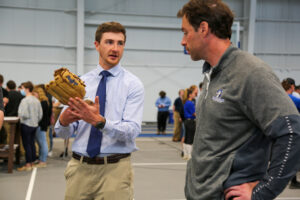A group of five recent Elizabethtown College Engineering graduates, consisting of current and former student-athletes Erika Antunes ’22, Grace Butler ’22, Joey Thomas ’22, Eric Sipling ’22, and Jordan Sweger ’22 developed a creative and functional prosthetic designed to increase inclusivity for amputees in sports.
The design, dubbed “Clutch Catch,” allows hand and wrist amputees the opportunity to return to high-level baseball play using a mechanical glove that allows the wearer to catch a baseball, access it easily during play, and reset the glove to catch again.
The team chose to focus on Clutch Catch in part because of their shared interest in sports. Thomas and Sipling were standout members of the 2022 Landmark Conference-winning Blue Jay baseball team, while the other members of the project were current or former student-athletes themselves.
“Being an athlete drew me to this type of project, especially since I was a baseball player,” Sipling said. “It allowed me to combine my education with my hobbies to create something totally new.”
The more the group looked into the sports prosthetics market, they realized that most prosthetics on the market resembled lacrosse heads, but in no way resembled a hand with conventional catch-and-release mechanisms. Noting this, the team set to achieve a sports prosthetic that mimicked the catch-release abilities of a functioning hand.
 The journey to creating the finalized version of Clutch Catch had some bumps before it reached its final iteration.
The journey to creating the finalized version of Clutch Catch had some bumps before it reached its final iteration.
“This project was a lot of trial and error,” Antunes said. “Every week we were in the fabrication lab tinkering with the product… Some weeks led us to make extreme changes to the design, and other weeks we added something small like a piece of aluminum inside the rotational spring to keep it from bending.”
With the help of engineering faculty and staff from the School of Engineering, Math, and Computer Science, the team was able to problem-solve and eventually land on the final design.
“Every member took on an important and distinct role that allowed the team to accomplish a project of significant scope,” Associate Professor of Engineering Brenda Read-Daily said. “They showed remarkable adaptability at diving into creative design and prototyping to identify and solve technical challenges.”
After much back-and-forth, the result was a slot design glove that allows for a solid snap shut, easy access to the ball, and an effortless reset to the mechanism, with a 100% success rate in speed ranges of 30-39 miles per hour (mph) and 50-59 mph and a 90% success rate in the speed range of 40-49 mph.
Though Clutch Catch has received recognition from faculty and the opportunity to present at an upcoming biomechanics conference, for many members on the team, the true accomplishment will be how their design helps others- a sentiment that is echoed in the engineering department motto “Educate for Service, Engineer for Society.”
“For many, sports are outlets,” Antunes said. “They allow us to escape reality for a bit. They teach us valuable life skills like time management, hard work, and teamwork. We knew we could help someone feel equal to their peers and participate in the sport that they love by creating a prosthetic with full catch-release mechanics. This design may not be finalized, as it can always be improved, but it allows people to envision how we can change the prosthetic market to be more inclusive and more effective for athletes who want to compete at a high level amongst their peers.”
Butler went on to present her team’s senior project at the North American Congress of Biomechanics (NACOB), which took place in Ottawa, Quebec in late August. The conference gave Butler a unique opportunity to network and present to members of Major League Baseball (MLB) were in attendance during Butler’s presentation, including a representative from the New York Yankees.

